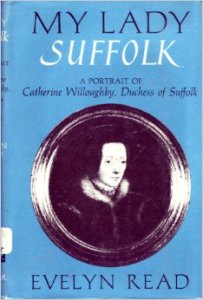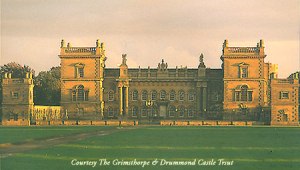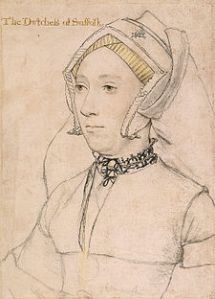In 1931 the Oxfordian researcher Eva Turner Clark suggested that a play performed at Richmond Palace on January 1, 1579 was an early version of The Taming of the Shrew by Edward de Vere Earl of Oxford, containing the farcical war of words between Katharina and Petruchio to caricature the marriage of his sister, Lady Mary Vere, and Peregrine Bertie, son of Richard Bertie and Catherine Willoughby Duchess of Suffolk. The play was recorded as A Morrall of the marryage of Mynde and Measure, which may refer to the “measures” by which Petruchio plans to tame the “mind” of Kate, his willful bride.

(Grandma’s Graphics)
http://www.grandmasgraphics.com/index.php – Click on Image to Enlarge the View
Ms. Clark cited a letter from Thomas Cecil in September 1578 to his father, William Cecil Lord Burghley, reporting that an “unkindness” had grown between the young bride and groom ever since the wedding in December 1577, adding his prediction that Lady Mary “will be beaten with that rod which heretofore she prepared for others.” That is, Peregrine Bertie was going to “tame” his “shrew” of a wife with her own sharp-tongued medicine.
Peregrine would later become known as “brave Lord Willoughby” as well as Oxford’s good friend. (In 1582 he would visit the royal Court of Denmark and bring back reports which, it appears, were available to the author of Hamlet.) In any case, as Ms. Clark suggests, Oxford found the verbal battles between his sister and brother-in-law to be ready-made fodder for his comedy:
“Lord Oxford was far from being mindful of the feelings of others; and if his characterizations of Katharina the Shrew were recognized at Court as a portrait of Mary de Vere, Lady Willoughby, this would have greatly added to the enjoyment of the play.”
That’s pretty much what I recalled about this matter until recently re-reading My Lady Suffolk (1963), a portrait of the Duchess by Evelyn Read, wife of Conyers Read, best known for his two-volume biography of William Cecil Lord Burghley. Ms. Read includes details which, in my view, make it virtually certain that Oxford drew upon the unhappy marriage of his sister and Peregrine Bertie for what would become The Taming of the Shrew as by Shakespeare: the new bride and groom, finding themselves alone together in a home out in the countryside, were so fond of wine that they got into wild drunken arguments while making a mess of the place. Ms. Read describes it in more delicate language:
“After their marriage, Peregrine and his bride went to live at Grimsthorpe [the great Lincolnshire manor], while Catherine and Richard Bertie stayed in London. They moved into a house in Hampstead, which at that time was not part of the city but was country, and somewhat rolling country at that … In spite, however, of the beautiful surroundings in which they started their life together, Peregrine’s marriage to Lady Mary did not begin auspiciously. The bride’s temper was a hot one, and perhaps Peregrine himself was none too patient. Also, it appears that they took no pains at all in the upkeep of Grimsthorpe.”
On March 12, 1578, the Duchess wrote to Burghley about her fears that the young couple will “so govern” the mansion “as my husband and I shall have small comfort of it and less gain,” adding that she and her husband would have to pay “for what disorders they make … That my Lady loves wine,” the Duchess went on, asking rhetorically, “Who knows her knows not that?” [In other words, Mary’s love for wine was no secret; and neither, for that matter, was that of her brother Edward.] “And my son hates it not,” she continued, by way of sarcastic understatement; but then, in a strange twist of logic, she requested Burghley to allow the couple to import two more barrels or casks of wine, adding her prediction “that it shall be all drunken quickly in their house than orderly or well spent.”
Ms. Read continues: “Catherine went on to ask Burghley to do this as promptly as he could, in order that the young people would stay longer in the country, ‘if they outrage not too much so as we shall not be able to bide it.’ This letter is revealing of Catherine’s concern about the way her son and his wife were living, and of the fact that apparently she felt that they were drinking more than was good for them. It seems surprising that she asked Burghley to make the wine available to them, since obviously she did not approve of the way they would drink it; but perhaps she had faced the fact that they were going to do it anyway, and felt that on the whole it was better for them to stay in the country than to come back to town, which they might well do if they could not get what they wanted at Grimsthorpe.”
Six months later Thomas Cecil wrote to Burghley that he and his wife were traveling and stopped to see Peregrine and Mary at Grimsthorpe, where they found “such disagreements as have fallen out there.” He added that “more particularly as yet I cannot write at this time,” except for his prediction that “Lady Mary will be beaten with that rod which heretofore she prepared for others.”
The Duchess of Suffolk continued to be heartbroken over her son’s marriage up to her death on September 19, 1580, at sixty-one. In March of that year, she had written to the Earl of Leicester about “the evil hap of my dear son’s marriage” and pleaded with him to reassure Queen Elizabeth that she was not in danger of “losing my head.” As long as Catherine Willoughby lived, Ms. Read notes, she could not help her son: “Obviously Lady Mary was behaving very badly, and obviously part of her bad behavior was directed at Peregrine’s mother” – but exactly why Mary railed so bitterly against the Duchess is apparently lost to history.
The troubled marriage of Oxford’s sister must have been gossip whispered throughout the royal court. When Petruchio declares that he is “born to tame you, Kate, and bring you from a wild Kate to a Kate comfortable as other household Kates,” most members of that select audience would have roared with knowing laughter.
P.S. — I’ll have more about the outspoken, formidable Catherine Willoughby, Duchess of Suffolk, in the near future.



Enjoyed this, looking forward to more. Though there’s no way of knowing I wonder if religion entered into the poor relations with her mother-in-law considering the Catholic circles her brother and sister moved in, prior to 1581 for Oxford and possibly throughout her life for their sister Catherine. I also suspect Oxford remained closer to his Catholic roots than the record shows.
Click to access fox.pdf
I found this article interesting because it really sketches out the Catholic circles of Edward Windsor and Catherine DeVere. Edward Windsor’s sister who married a Brome spent many years imprisoned for her religion, most of their sisters married recusants, and of the woman in the family it is said that “two generations of wives and sisters formed a recusant network in themselves”. This was also true of the men with, for instance, the Giffords, Ferrars of Baddesley Clinton and the older Lord Norrys all close associates of Sir Christopher Brome, Edward Windsor’s brother-in-law.
To me the Catholic context is what has been missing from authorship studies. I did start a blog this week to hopefully start bringing that aspect more into focus as well as looking hard at authorship connections. This post explains it:
You’ve all given me so much, I’m hoping I can give back a little to the community now.
Great news from you! I hope to be following your blog as it goes along. Thanks!
I just made a correction (Bromwich was the half great uncle of Essex) and strengthened the reference links. Should be good now!
There were many unhappy marriages from this period. Oxford’s mother left his father’s household when he seemed to favor the company of his miscreant friends than his wife and child. A scenario that could have influenced Lear as much as Taming.
But, if you are looking at the Berties, Susan Bertie, Countess of Kent, was not particularly happy in her first marriage. I believe you have written before about Kent’s street fighting with Peregrine. The fellow was a snob, thug and worthless human being. Bertie Senior petitioned for redress; but, it is not clear what, if anything, was done.
In furtherance of the foregoing, Lord Willoughby, I came across a letter from Capt. John Buck to Lord Willoughby, dated 21 November 1595, in the course of reading some of the papers of Peregrine Bertie, . Here is the paragraph that caught my attention:
I see that your Lordship holds your old course, to wrong them most who take greatest pains to hold your love without charging your purse. I am like a good spaniel, who, the more he is beaten, the fonder he is of his master. You say that I gain by the use of your money. If you looked as carefully to others that have your money as you do suspiciously at your honest friends, you haply might profit more at the year’s end. I send you your money before ever I receive it, with charge and trouble for which I look for no thanks. I might say it were good you gave me interest for my old debt, but “I look for neither till you be exceeding rich,” for I think I love you and care more for your business than you do yourself.
The reason this caught my attention is that it is strikingly similar to the following lines in A Midsummer Night’s Dream (2.1; TLN 577-585):
And even for that do I love you the more.
I am your spaniel; and, Demetrius,
The more you beat me, I will fawn on you:
Use me but as your spaniel, spurn me, strike me,
Neglect me, lose me; only give me leave,
Unworthy as I am, to follow you.
What worser place can I beg in your love,–
And yet a place of high respect with me,–
Than to be used as you use your dog?
Similar language is found in Two Gentlemen from Verona (4.2; TLN 1644-45)
Yet, spaniel-like, the more she spurns my love,
The more it grows and fawneth on her still.
According to Dent, R. W. Shakespeare’s Proverbial Language: An Index (Berkeley: University of California Press, 1981) 215, the foregoing are variants of the proverb “The spaniel, that fawns when he is beaten, will never forsake his master.” Dent also cites Lyly: “Wilt thou resemble the kind spaniel which the more he is beaten the fonder he is, or the foolish eyas.” Lyly, John, Morris W. Croll, and Harry Clemons. Euphues: the Anatomy of Wit; Euphues & His England (New York: Russell & Russell, 1964) 95 (footnotes omitted). There is a similar proverb (perhaps a variant) in the Oxford Dictionary of Proverbs: “A spaniel, a woman and a walnut tree, The more they’re beaten the better still they be.”
Nonetheless, there is a faintly Shakespearean ring to Buck’s words that give pause.
Thanks very much, Gary. Great to have such information. At the same time it opens up many new questions. Are those papers available online? Are you working on a project? In any case, much appreciated.
The letter is in the National Archives database: http://discovery.nationalarchives.gov.uk/details/rd/35c953bb-d61e-4f15-8ded-859af2dd0988#1-335
I am not working on a project per se. At one time, I thought Peregrine’s mother might be the Lady of the Strachey because she had married a commoner. However, if you look into the Greys and the other women associated in one respect or another with the Duke of Suffolk, several married “beneath” them.